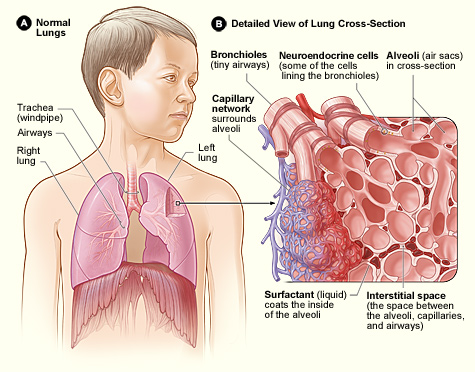How Did Mumbai Doctors Implement Stem Cell Treatment Curing Premature Rudransh’s Lung Disease?

Cross-sectional detail of the lung. Source: public domain
By News Desk, Neucrad Health India May 31, 2019
In a pioneering medical advancement, doctors at Surya Mother and Child Care Hospital of Santacruz treated broncho-pulmonary dysplasia (BPD) in a premature baby. Rudransh Dubey was born on 27th June 2018 to Chandivali based couple Promod and Meenakshi Dubey during his 26th week of gestation (under normal circumstances the gestation period is 39 weeks) at Cloudnine Hospital in Malad. He was premature and weighed barely 600 grams. Usually, babies born below 1 kilogramme tend to have several underdeveloped organs and remain prone to infections.
What happened to Rudransh immediately after birth?
Rudransh got diagnosed with severe BPD, respiratory distress, anaemia, along with low platelet counts. His air sacs were small and underdeveloped. According to research, babies born between 1 to 1.5 kilogramme have a 15 per cent chances of developing congenital lung problems. These lung ailments rise to 50 per cent when new-borns are below 1 kilogramme. Rudransh started turning blue due to hypoxia and got shifted to a ventilator. When his condition failed to improve, his parents transferred him to Surya Mother and Child Care Hospital for advanced treatment in September 2018.
How did the doctors in Surya Mother and Child Care Hospital cure Rudransh condition?
The medical team of Surya Mother and Child Care Hospital initially tried administering steroids, vitamins, and surfactants for the growth of lungs and wean him off the ventilator support. However, Rudransh’s condition deteriorated with each passing day even after keeping in a high-pressure ventilator. In such a scenario, Dr Nandkishore Kabra, a senior neonatologist and director of Neonatal ICU of Surya Hospital, decided to try stem cell therapy to revive the baby. The hospital administration took the approval of Rudransh’s father, Mr Pramod Dubey before implementing this treatment as there is very less experimental evidence on the success of stem cell therapy, especially in below six-month-old babies. They injected approximately 40 million stem cells in the baby’s lungs with the help of the intratracheal tube in four doses. Doctors collected these stem cells from the umbilical cord of a donor.
How did Rudransh react to Stem Cell Therapy?
Within ten days of receiving the stem cells, Rudransh’s lungs started developing, and his ventilator support was going down significantly. The doctors began measures to wean him off the ventilator support followed by continuous positive airway pressure (CPAP) machine and oxygen support gradually. Finally, on 11th March doctors decided to discharge the baby from the hospital with an increased weight of 4.6 kilogrammes. The entire treatment procedures were carried out free of cost as a humanitarian gesture.
What is the reaction of Scientists and Doctors all over the world about this treatment?
Stem cells are the raw cells of the body which can transform into other cells with a specific function. Stem cell therapy is the use of these cells in treating or preventing the occurrence of a disease. The treatment of BPD in Surya Hospital was a pioneering activity in medical history, where doctors implemented intra-pulmonary stem cell therapy to cure a baby of bronchopulmonary dysplasia. Before this, research scholars in Korea utilised mesenchymal stem cells in babies for preventing the development of BPD, and doctors in Australia implemented amnion stem cells intravenously in babies to research their safety. It is the first time in the world doctors used intra-pulmonary stem cells for treating congenital lung deformity. It has opened newer avenues for research in Medical Science.
The Indian Council of Medical Research (ICMR) still does not approve administering stem cells in newborn babies as it can lead to infection, a sudden increase in heartbeat rate, and even cancer. Though the medical team of Surya Hospital followed every guidelines and protocol mentioned in the Declaration of Helsinki, ICMR has asked doctors to be cautious and undertake more research in this field.






